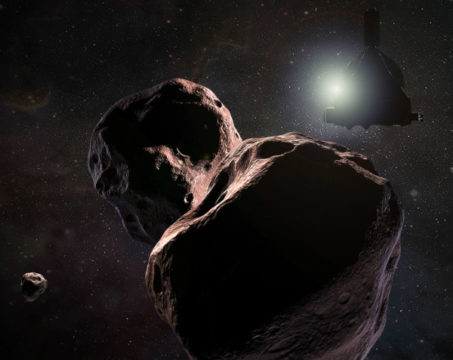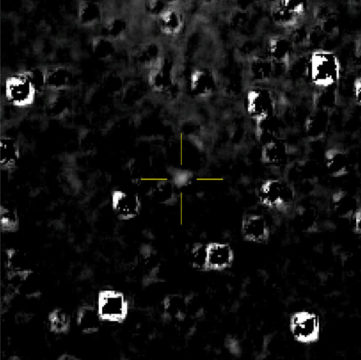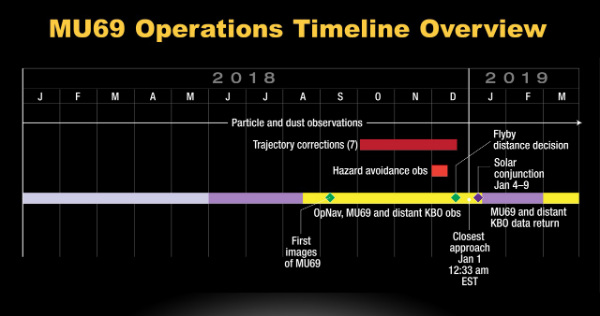Take a look behind the scenes as the New Horizons team gears up for the historic first flyby of a body in the remote Kuiper Belt, in this first of a four-part series from the mission's Principal Investigator Alan Stern.

NASA / JHU-APL / SwRI / S. Gribben
As I write these words, NASA’s New Horizons spacecraft, which explored the Pluto system in 2015, is now almost a billion miles beyond Pluto and bearing down on its next flyby target at a rate of over 1 million kilometers per day. The target is the Kuiper Belt object (KBO) 2014 MU69, nicknamed Ultima Thule. That name, pronounced “Ultima Tooly,” is Latin for “beyond the farthest frontiers” and was chosen in a public naming contest because its meaning represents what we are doing: exploring the farthest (and likely the most primitive) object ever visited in space.
Our team discovered Ultima (as I usually call our target) in 2014, using the Hubble Space Telescope. Ultima’s orbit, which is nearly circular and at a distance of 44 a.u. (6.6 billion kilometers) from the Sun, is in a special region of the Kuiper Belt called the cold classical belt. Whereas most objects in the Kuiper Belt formed among the giant planets and later moved outward to their current orbits, bodies in the cold classical region actually formed at their current location. As such, its members, like Ultima, represent a valuable bedrock sample of the ancient outer solar nebula.
With a diameter of just 25 or 30 kilometers (16 or 19 miles), Ultima is an order of magnitude larger and about 1,000 times more massive than typical comets from the Kuiper Belt. As such, it could reveal important aspects of the planet-building process by showing us the next step up the ladder of accretion that built still larger KBOs and small planets such as Pluto.
When NASA called for proposals to explore the Pluto system back in 2001, each proposing team was required to demonstrate that their spacecraft and instruments were capable of also going on to explore a Kuiper Belt object after investigating Pluto.
Now we’re actually carrying that part of the mission out. And as we do, I’ll be writing a series of blogs for Sky & Telescope, giving you a ringside seat from here in the Principal Investigator’s chair, behind the scenes. In this first blog, I want to summarize what’s going on now as we begin to bear down on Ultima.

NASA / JHU-APL / SwRI / KinetX
Aboard the spacecraft, which is still tens of millions of kilometers from its closest approach to Ultima set for January 1st, 2019, the primary activities are two fold. First, the spacecraft is using its most sensitive telescopic imager, called LORRI (for Long Range Reconnaissance Imager), to image our faint target in the distance against the star fields of Sagittarius, where Ultima appears on the sky. These optical navigation (or OpNav) images, sent back to Earth each week, are used by our navigation team to refine our knowledge of Ultima’s orbit and from that, compute trajectory correction maneuvers to home in on our target. We do that because the mathematics of the flyby require us to arrive within just a few tens of kilometers of our aim point and a few hundred seconds of the planned arrival time in order for the many mapping observations to succeed.
Members of our science team are also using the OpNav images to search for moons or rings around Ultima that could pose a hazard to our spacecraft. If we spot such a danger, we’ll have to burn the engines to retarget to a safer flyby distance, farther out than the 3,500-kilometer nominal aim point we’re hoping to home in on. So far, no such hazards have been found, but as we get closer each week, LORRI is able to detect fainter rings and smaller satellites.
The other major spacecraft activity taking place now is the use of our two charged-particle radiation sensors and our dust detector to characterize the Kuiper Belt radiation and dust environment in which Ultima orbits. This environmental characterization is important to our ability to understand the subtle ways the Kuiper Belt environment has shaped Ultima’s surface composition, reflectivity, and other characteristics, once we obtain high-resolution imagery and compositional spectra of our target.
Meanwhile back on Earth, our ground team — consisting of flight controllers, engineers, and scientists — is putting the final touches on the flyby sequence that will instruct New Horizons for the all-critical, nine-day, close-approach period when Ultima will grow from a dot in the distance to a world we will explore. What that exploration consists of will be the subject of my next blog. Stay tuned!

NASA / JHU-APL / SWRI
 6
6









Comments
Donald Bruns
November 5, 2018 at 3:57 pm
Is the 12:33am EST closest approach in Earth time, or Kuiper Belt time?
You must be logged in to post a comment.
Peter Wilson
November 6, 2018 at 11:30 am
I think Thule is on DST...
You must be logged in to post a comment.
opticsguy
November 10, 2018 at 12:15 am
Chasing New Horizons is my current favorite book.
For me, the New Horizons is the most interesting and exciting spacecraft mission since the moon landings. Having "observed" Pluto in my scope almost every year for the past 23 years, I find this faint spec of light very interesting indeed!! The flyby of Ultima Thule will again be another highlight in mans exploration of our universe.
Thank you to New Horizons and all the incredible people who have worked so hard to make this dream come true!!
You must be logged in to post a comment.
Jim-Baughman
November 10, 2018 at 2:03 pm
Your headline—First Exploration of a Kuiper Belt Object—is incorrect. New Horizons has already visited Pluto, which is a Kuiper Belt Object, therefore MU69 is the second KBO NH will visit, provided we don’t count Charon and Pluto’s other moons as KBOs themselves. (In fact the controversy surrounding demoting Pluto from planet status was resolved by simply reclassifying it as a KBO.)
You must be logged in to post a comment.
Don-Price
November 11, 2018 at 6:19 am
Pluto is a planet.
Don
You must be logged in to post a comment.
Jim-Baughman
November 13, 2018 at 12:28 pm
How’s the weather back there in 1993?
You must be logged in to post a comment.
You must be logged in to post a comment.